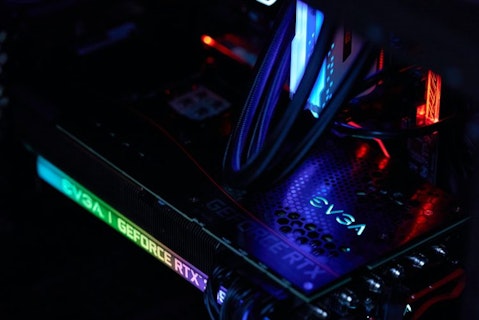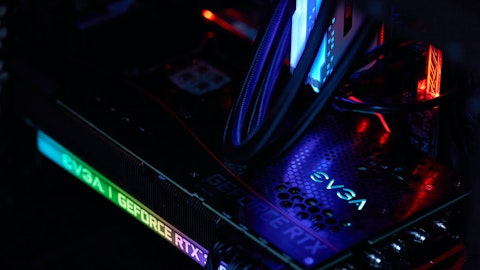SaltLight Capital Management, an investment management firm, published its first quarter 2021 investor letter – a copy of which can be downloaded here. A fairly robust performance from the SaltLight SNN Worldwide Flexible Fund during the first quarter of 2021 as conditions for equities were rather favorable. You can view the fund’s top 5 holdings to have a peek at their top bets for 2021.
SaltLight Capital Management, in its Q1 2021 investor letter, mentioned NVIDIA Corporation (NASDAQ: NVDA), and shared their insights on the company. NVIDIA Corporation is a Santa Clara, California-based computer systems design services company that currently has a $405.3 billion market capitalization. Since the beginning of the year, NVDA delivered a 24.58% return, extending its 12-month gains to 84.69%. As of June 01, 2021, the stock closed at $650.58 per share.
Here is what SaltLight Capital Management has to say about NVIDIA Corporation in its Q1 2021 investor letter:
“In this letter, we highlight one ‘bet’: a follow-up on our December letter where we wrote extensively about our broad thesis about the Artificial Intelligence opportunity. We present a case study of NVIDIA who we believe is delightfully positioned to capture this opportunity.
Unfortunately, for some readers, again this letter tends to overflow in technical IT jargon. Part of our mission is to educate co-investors about our thinking over the long term. We attempt our best to moderate complexity, however, sometimes the technical analysis is the only way to reinforce the thesis.
Encouragingly, we continue to find global opportunities to deploy capital. We remain cautious on South Africa and believe that, overall, distribution of outcomes is skewed to the downside despite the recent mean reversion in share prices. We believe that we own the best of the South African opportunity set. Therefore, the majority of incremental capital in the fund is being deployed into global opportunities.
Notwithstanding, we’ve increased our position in one South Africa business that will directly benefit as the population is vaccinated. We’ve also participated in two special situations that are still yielding satisfactory returns on capital.
A quick read of our factsheet will show high cash balances. This is slightly misleading as a substantial portion of the cash is backing derivative exposures that are not reflected in the disclosure.
NVIDIA is one of our portfolio companies that, we believe, has considerable potential. Their recent GTC conference confirmed some elements of our long term thesis:
• As leading enterprise customers started to find competitive advantages adopting AI solutions, their competitors would need to heavily invest in keeping up.
• NVIDIA is creating layers of ‘tools’ to solve the input and output bottleneck challenges that we mentioned in our December letter.
• On top of this, and fortunately for us, geopolitical and COVID-related factors added further tailwinds and a well-known shortage of semiconductors across the industry ensued.
Speak to your brother-in-law who works in IT and he would probably associate NVIDIA as a gaming hardware company. However, over the last few years, NVIDIA has been building an AI platform company with integrated hardware, developer ‘middleware’ and AI applications. Gaming has funded this platform, but AI is likely to define NVIDIA over the next decade.
As an aside, we think co-founder and CEO Jensen Huang, is one of the most impressive CEOs that we’ve come across. It is customary amongst tech CEOs to have a signature clothing ensemble; Jensen is no different and he frequently sports a ‘glossy’ black leather jacket. Since the COVID-era, Jensen has presented all of NVIDIA’s product launches from his kitchen. For those not familiar with the sector, it is worthwhile contextualising how they got here.
One of the key inputs in AI is the hardware for computational power – particularly deeplearning models. Compute power is determined by semiconductor architecture, packaging and the software layer to extract maximum performance.
Gaming has funded the future AI platform
Whilst Intel will be associated with dominating the central processing unit (CPU), NVIDIA almost already owns the space for Graphics Processing Units (GPUs); the primary reason – gamers.
Toward the end of last year, the company launched its 3000 series with much excitement from gamers. As of writing this letter, they are extremely hard to get hold of. The ‘street price’ is as high as three times the recommended sales price.
NVIDIA earns software-like gross profit margins of 63% whilst technically earning most of its revenue from hardware. However, if this premium ‘street price’ is any indicator, NVIDIA could charge substantially more to earn higher margins. The consumer surplus is evident.
Why are customers willing to pay three times the retail price for an NVIDIA GPU?
Hard-core gamers desire to submerge themselves in the worlds that they play in. They don’t want to be in an animated world, they want to feel like they are there. The GPU brings them closer to ‘reality’ through high fidelity and immersive experiences.
We can share an anecdotal picture of where things are going: Epic Games (40% owned by Tencent) recently announced a ‘Metahuman Creator’ software kit that simulates virtual humans for games and movies. At this stage, the only GPU that can handle the software in real-time is the new NVIDIA GPU. We’d personally be scared of becoming an actor when we see what can be created by software.
In most computer-generated images, it is often quite clear that the image is not a photo. The human eye is able to easily differentiate between an animated image and a real photograph. There is just something off about it.
One of the missing links is that, in the real world, light bounces off all objects in a particular environment and does not only emanate from the sun or direct light sources. Games have got better with a technique called rasterisation where shadows and shades of colour simulate a deeper sense of light, depth and context. However, to solve the ‘light bouncing off all objects’ problem, the game engine needed to keep track of each object, where it was located, its position relative to others and what light bounced off its surroundings. The computational requirements were just too much at the time.
However, with developments in computational power, ray tracing was finally commercially introduced by NVIDIA in 20185. Ray tracing is a rendering technique that simulates the many paths of light emanating from objects in the image whilst obeying the laws of physics.
Hardware + AI Models
You can imagine that this is a computationally-intensive process. Yet, even with the latest technology, GPUs still can’t fully replicate the infinite light interactions that occur in the real world. NVIDIA came up with a deep learning model, called DLSS, to use AI software to enhance what the hardware still can’t do. The model essentially fills in the gaps. A GPU plus DLSS create an incredibly realistic image and is driving demand for upgrades of the new 3000 series.
You may be asking, what does this have to do with NVIDIA’s AI platform? As it happens, the same mathematical approach to solving complex rays of light is very similar to the types of calculations needed for AI.
GPUs are structurally superior for AI problems
At its essence, an AI algorithm is a linear algebra problem optimised through brute force. There are trillions of calculations that need to happen very quickly.
CPUs are good at doing many different tasks, GPUs are good at doing one specialist task very well. In layman’s terms, the CPU is a Swiss Army Knife, and the GPU is a surgical scalpel.
GPUs carry out repetitive linear algebra calculation in parallel threads. Conversely CPUs are fast processors in their own right, but they handle mathematical operations sequentially rather than parallel. This makes the CPU processing time orders of
magnitude slower than a GPU.Hardware to Building an Ecosystem
It is becoming clearer that NVIDIA’s strategy is to use its leading position in GPUs (or what really should be called ‘AI’ hardware) to build an AI ecosystem by tying in hardware users into their software (middleware and applications).
We believe that this integrated stack could build a considerable moat over the next decade.
NVIDIA’s strong position
Right now, it’s for NVIDIA to lose this substantial future opportunity.
• Making AI simpler: Today, a PhD is required to develop a well-trained deeplearning model that generates substantive value. Unfortunately, we ‘average’ users would generate a subpar model that has many false positives and as a result, a model that doesn’t accurately predict the desired results. The blue-sky opportunity is for a company to make it considerably easier for enterprise and SME customers who can’t hire PhDs to use AI to their benefit. We’re talking about software as easy as Excel and Word for AI problems. If this opportunity is solved, it will exponentially grow the AI total addressable market (TAM).
• Building AI Infrastructure: The challenge is that the AI foundational blocks don’t yet exist at scale. The ‘highways, piping and ducts’ still need to be built. NVIDIA is slowly laying the building blocks to do that in place by launching network accelerators, pre-trained deep-learning models and hyper-scale supercomputers that solve high computational problems such as weather
prediction and gene sequencing.Providing tools for developers that eventually build a moat
NVIDIA’s CUDA SDK6 is the primary software that interfaces with their GPU. As they have the most advanced GPUs, by virtue of being the first mover, scientists repurposed gaming GPUs for their particular use case. Seeing a new market of users, NVIDIA provided the software to maximise the performance of the GPU for free. As the AI opportunity has become more established, CUDA has become the de facto parallel processing software SDK used by developers.
This is a critical place to be to build a moat and 2.3m developers already use NVIDIA SDKs. But we’ve seen this movie before.
Developers are the enablers
Two decades ago, Bill Gates became very wealthy because MS-DOS was in a similar position. Operating Systems are the structural foundation for developers to create their applications. Many books have been written about how IBM handed the opportunity to Gates on a platter. However, the reality is that developers were the real enablers. Operating systems have high switching costs for a developer who would have to completely rewrite their application to work on a different operating system. Therefore, they stick with it even if a better operating system comes along.
And so, over time, the software ecosystem develops; more applications and users, which means more developers, which means more applications and users. In a few years, Gates is the richest man on Earth! This is a great example of software network
effects.NVIDIA believes that gaming was just the first ‘killer app’ that excelled using their technology. It’s early days into what could be a very large opportunity. NVIDIA has generally sold ‘shovels’ to hopeful prospectors. It is starting to become a prospector itself…”

jose-g-ortega-castro-sKZ_qkgg8T0-unsplash
Our calculations show that NVIDIA Corporation (NASDAQ: NVDA) does not belong in our list of the 30 Most Popular Stocks Among Hedge Funds. As of the end of the first quarter of 2021, NVIDIA Corporation was in 80 hedge fund portfolios, compared to 88 funds in the fourth quarter of 2020. NVDA delivered a 17.50% return in the past 3 months.
The top 10 stocks among hedge funds returned 231.2% between 2015 and 2020, and outperformed the S&P 500 Index ETFs by more than 126 percentage points. We know it sounds unbelievable. You have been dismissing our articles about top hedge fund stocks mostly because you were fed biased information by other media outlets about hedge funds’ poor performance. You could have doubled the size of your nest egg by investing in the top hedge fund stocks instead of dumb S&P 500 ETFs. Here you can watch our video about the top 5 hedge fund stocks right now. All of these stocks had positive returns in 2020.
At Insider Monkey we leave no stone unturned when looking for the next great investment idea. For example, lithium mining is one of the fastest growing industries right now, so we are checking out stock pitches like this emerging lithium stock. We go through lists like the 10 best hydrogen fuel cell stocks to pick the next Tesla that will deliver a 10x return. Even though we recommend positions in only a tiny fraction of the companies we analyze, we check out as many stocks as we can. We read hedge fund investor letters and listen to stock pitches at hedge fund conferences. You can subscribe to our free daily newsletter on our homepage.
Disclosure: None. This article is originally published at Insider Monkey.





